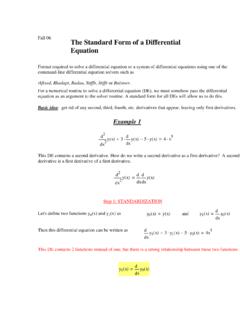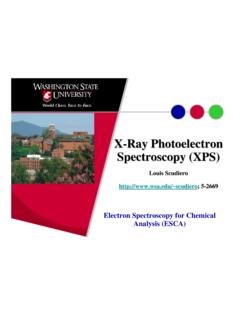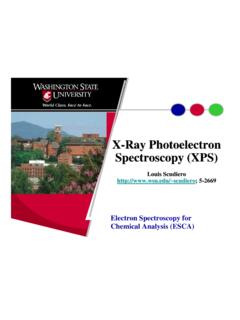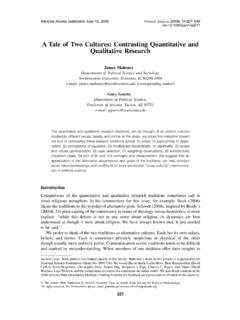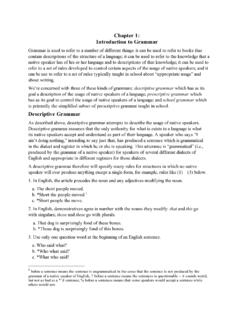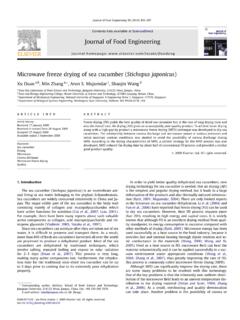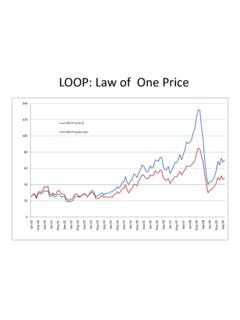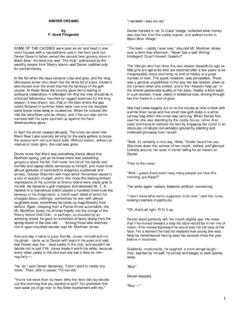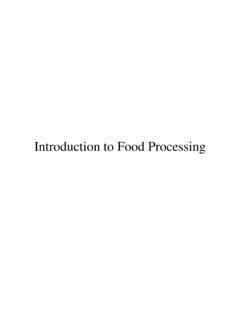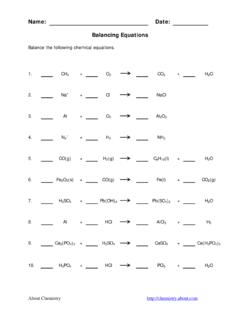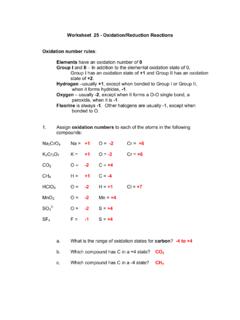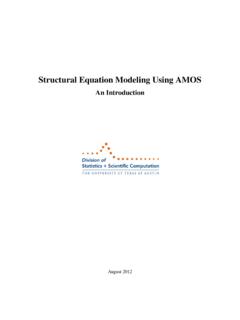Transcription of Vibrational-Rotational Spectra of HCl and DCl
1 Vibrational-Rotational Spectra of HCl and DCl Presented By Matt Moberly Lab Partner: Mike Stratton Presentation Outline I. Introduction a. Purpose b. Theory c. Equations II. Experimental Method III. Results a. Spectra b. Calculations and Error Analysis c. Theoretical Calculations IV. Conclusion V. References Introduction Purpose: Use the infrared vibrational spectrum of HCl and DCl to obtain the following: Moment of Inertia, Ie Internuclear Separation, re Force Constant, k Evidence of the Isotope Effect Theory: Simplest vibrating diatomic model is a harmonic oscillator described by1: E ( ) = hv ( + 12 ). Simplest rotating diatomic model is the rigid rotor or dumb-bell model which can be pictured as two masses joined by a rigid, weightless rod and described by1: 2. h E (J ) = J ( J + 1). 8 I 2. This more complete energy expression contains both rotational and vibrational parts as well as a final coupling portion1. E( , J ) ~. = ve ( + 12 ) v~e xe ( + 12 )2 + Be J (J +1) De J 2 (J +1)2 e ( + 12 )J (J +1).
2 Hc ~. v Vibrationa l Frequency e x Anharmonic ity Constant e B rotational Constant e D rotational Constant e Coupling Constant e Infrared absorption or emission can only occur at allowed transition levels vibrational : = 0, '= 1. rotational : J = 1. R and P branches Spacing between peaks Isotope Effect: mass difference between atoms effects the vibrational and rotational energies Splitting of peaks (35Cl and 37Cl). Compaction of heavier isotope spectrum Shift to higher wavelengths, . Equations: Linear Regression Equation2: (1) ~. v = Forbidden Frequency v~( x) = v~ 0 + (2Be 2 e) x ex 2 4 Dex3 0. rotational Constant3. ( 2) rotational Constant is rearranged solving for . (3). the Moment of Inertia, Ie h h B = I =. h, Planks Constant: J s 8 I c e 8 B c 2 e e 2. e c, Velocity of light (in vacuum): m s-1. Moment of Inertia, Ie1. (5) Moment of Inertia is rearranged solving for . ( 4). Internuclear Separation, r I = r I N , reduced mass: mAmB/(mA+mB). r =. A. 2 e e NA, Avogadro's Constant Frequency of Forbidden Transmission1.
3 (7). ( 6) 1. ~ ~ ~ . 2. v = v 2v x 0 e e e v~ = v~ . *. 0 e . *. 2v~ x . e *. Frequency equations are used to solve for the two unknowns xe Anharmonic ity Constant Frequency Equation3. (8 ) (9). 1. kN 2. k = 4 2c2v~e2 NA 1. ~ 1. ve = . A. 2 c .. Frequency equation is rearranged solving for the Force Constant, k Experimental Method Apparatus Acetone/Dry Ice bath in first trap condense and trap any D2O/ H2O or D3PO4/ H3PO4. Liquid N2 bath to protect the pump from formed gasses Changes to Apparatus4. Water condenser was not included Three-way valve was placed at position A. Manometer was placed between first Acetone/Dry Ice bath and three-way valve Preparation of HCl and DCl4. Reaction: 2 PCl5 + 8 D2O 10 DCl + 2 D3PO4. Since D2O is not pure both HCl and DCl are formed Approx. 2g of PCl5 (green) was placed in flask F. Initial reaction used less than 2 grams PCl5 which did not produce sufficient amounts of HCl/DCl gas The system was evacuated for approx. 15 minutes ml D2O was added to flask F with the cell opened which produced a violent reaction Gas Collection Once reaction was complete, the cell was closed, detached, and placed in the infrared spectrophotometer for analysis HCl and DCl Spectrum Calculations and Error Analysis: Equation (1): HCl Herzberg vol.
4 2 Relative Error v~0 = 2779 .23cm 1 v~0 = 2885 .10 cm 1 v~ 3 . 682 %. 0. e = 0 .2954 cm 1 e = 0 .3019 cm 1 2 . 141 %. e Be = 10 .558 cm 1 Be = 10 .591cm 1 B 0 . 306 %. e De = 6 .5422 x10 4 cm 1 De = NA D NA e Equation (1): DCl Herzberg vol. 2 Relative Error v~0 = 2086 .65cm 1 v~0 = 2091 .10 cm 1 v~ 0 . 198 %. e = cm 1. 0. e = cm 1 4 . 847 %. Be = cm 1. e Be = cm 1 B 0 . 537 %. De = x10 4 cm 1. e De = NA D NA. e Equation (3): HCl Herzberg vol. 2 Relative Error I = cm gm 40 2. I = cm gm 40 2. Equation (3): DCl Herzberg vol. 2 Relative Error I = cm gm 40 2. I = cm gm 40 2. Equation (5): HCl Herzberg vol. 2 Relative Error re = 1 .277 x10 8 cm re = x10 8 cm Equation (5): DCl Herzberg vol. 2 Relative Error re = 1 .272 x10 8 cm re = x10 8 cm Equation (6&7): Equil. Equation (9): HCl Vibrating Frequency for HCl and anharmonicity k = cm 1dyne c o n s t a n t klit = cm 1dyne v~e = 1. v~ x = 1. = e e xe = Theoretical Calculations5: HF Results MP Results re = 8 cm re = 8 cm v~e = cm 1 v~e = cm 1.
5 Be = 1 Be = 1. Potential Energy as a Function of Internuclear separation, re Potential Curve of HCl using Hartree-Fock (HF) and Moeller-Plessett (MP) Theories HCL Potential Cuve -459. 0 1 2 3 4 5 6. HF MP. Energy, J. -460. -10. Internuclear Separation, 10 m Conclusion Largest Source of Error likely from Spectra Readings Force Constant Coupling Constant Reduce systematic error by zooming in Use a new Cell Internuclear Separation fluctuates with Moment of Inertia, Ie , obtained is an average xe shows anharmonicity of HCl molecule is small Isotope Effect observed for 35Cl and 37Cl References 1 Shoemaker et. al., Expt. In Physical Chemistry, 6th ed. pg. 397. 2 Poshusta, HCl Spectrum Analysis, Mathcad 20 Dec. 1997. 3 Herzberg, G. Molecular Spectra and Molecular Structure I: Spectra of Diatomic Molecules. 2d ed., Van Nostrand, Princeton , (1950). 4 Henscheid, Leonard. Supplement to Expt. 38: Rotation- Vibration Spectrum of HCl and DCl. Chemistry 334 Handout, Washington State University (1998).
6 5 Poshusta, : Modeling the Spectrum of HCl with Ab Initio Quantum Chemistry. Chemistry 334 Handout, Washington State University (1998).
